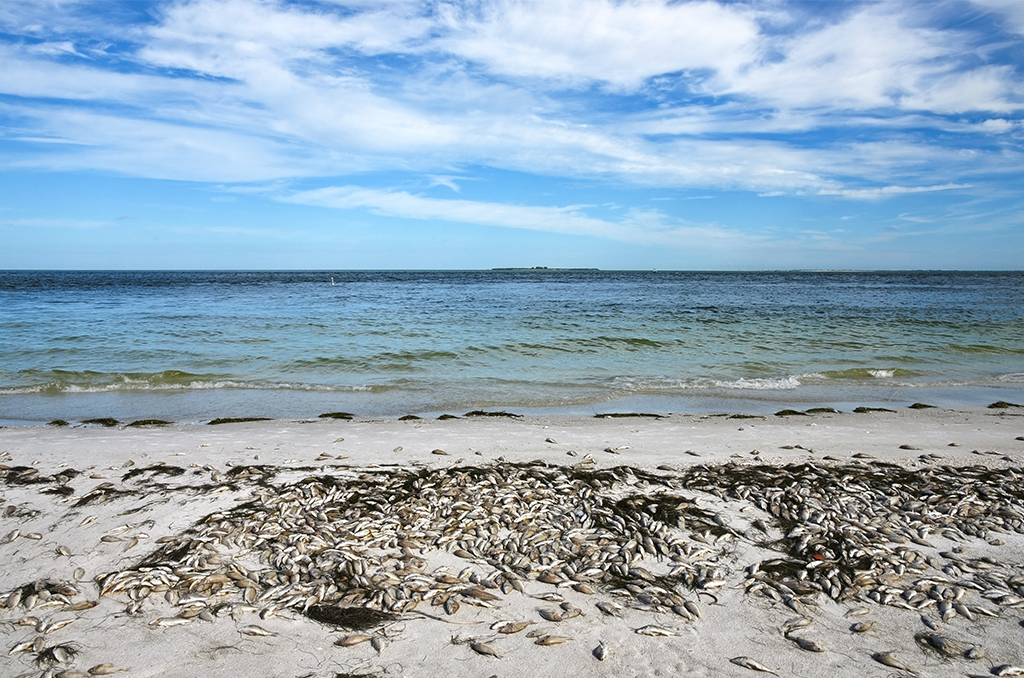Red Tide Beach Covered Dead Fish – Courtesy: Shutterstock – Image by Mark Winfrey
A red tide has made its way to the Gulf Coast of Florida, causing major problems for wildlife and its local communities.
As of last week, more than 613 tons of fish and marine life in and near Tampa have been killed by Karenia brevis, the bacteria that makes up red tide.
On Friday, the Florida Fish and Wildlife Conservation Commission stated that it had collected 132 samples from the area and found extremely high concentrations of the bacteria in the water in both Hillsborough and Pinellas counties.
According to the commission, fish deaths and respiratory irritation suspected to be related to red tide were reported in Hillsborough, Pasco, Pinellas, Sarasota, Manatee, and Lee counties over the past week.
The blooms aren’t necessarily limited to being red or blue-green. “Blooms can look like foam, scum, mats, or paint on the surface of the water. A bloom can change the color of the water to green, blue, brown, red, or another color,” said the U.S. Centers for Disease Control and Prevention.
“Red Tide in some parts of Tampa Bay in the past few days tested at ten to 17 times the concentration considered “high,” which can cause significant respiratory issues in people as well as fish kills,” Pinellas County officials announced in a red tide update on July 13.
Community members fighting for change
Members of the Suncoast Surfrider Foundation, a non-profit organization that works to protect beaches and oceans, and several others in the community gathered together on Saturday, hoping to bring their concerns to Florida Governor Ron DeSantis.
Chair of Suncoast Surfrider, Thomas Paterek, said he knew he needed to do something when a friend called him hysterically because of the large amount of dead fish on the beach outside of his water rental business.
“Hearing that phone call sparked a fire in me, to say if nothing is going to be happening, the community needs to lead this,” Paterek said.
He then decided to organize the rally to try to spark immediate efforts, including enacting a state of emergency and closing the nearby Piney Point wastewater reservoir to help clean up the waterways.
“I think everyone in the community is frustrated,” he said. “When you see dead dolphins in the water, when you see dead manatees in the water, dead sea turtles… when you have captains who have fished in the area for decades say they have never seen anything like this, that is enough to declare a state of emergency and not just say it’s another naturally occurring harmful algal bloom.”
Connection to Piney Point
Scientists fearfully anticipated a large bloom after the Piney Point phosphogypsum stack dumped wastewater rich in nutrients directly into Tampa’s waters back in April. The high levels of phosphorus and nitrogen were some of the most concerning factors because they are notorious for fueling phytoplankton growth which can eventually lead to a potentially toxic algal bloom.
“While it’s unlikely that we will be able to make a direct correlation between environmental harm manifested in Tampa or Sarasota Bays, it would be absurd to suggest that the impact isn’t significant,” said Justin Bloom, founder of the Suncoast Waterkeeper environmental organization.
And although algae blooms are a natural phenomenon that have been recorded for hundreds of years, the Environmental Protection Agency states that “nutrient pollution from human activities makes the problem worse, leading to more severe blooms that occur more often.”
In 2018, an enormous red tide bloom along Florida’s southwestern coast killed 2,000 tons of marine life. In addition, $8 million were lost in business losses.
Are you interested in Florida’s nature? For stories like this and much more: Florida Insider is dedicated to educating, entertaining and informing its readers about everything Florida. Easy to read content at the palm of your hands and covering the stories that matter.

